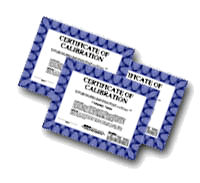
|
|

 NIST
Traceability
NIST
Traceability
 Dedicated
Calibration Lab
Dedicated
Calibration Lab
 Cutting
Edge Technology
Cutting
Edge Technology
 50
Year Record of Quality
50
Year Record of Quality
 Customer
Support & Service
Customer
Support & Service
|
Certified
Calibration Program
The
MISCO Certified Calibration program provides all the requirements for
the confirmation of calibration accuracies for handheld refractometers
and Abbe refractometers, and the preparation and control of certified
traceable measurement standards. The intention of this program is to
minimize uncertainty of measurements and minimize the risk of
refractometers producing results having unacceptable errors.
Further, this program provides compliance with International Standard
ISO 9000, ISO 10012-1:1992(E) and ANSI/NCSL Z540-1-1994.
Quality
Policy
The entire management and staff of MISCO is dedicated to the complete
satisfaction of each customers needs by providing our full personal
attention and the highest professional standards. Our key commitment is
to consistently exceed our customers' expectations, with respect to the
quality of our refractometers and services, at all levels of our
organization.
The objective of the certified calibration program is to assure the
highest standards of conformance of supplies and services and provide
for prevention of inaccuracy by the ready detection of deficiencies and
timely positive action for their correction. |
|
FEATURES
NIST
Traceable
All MISCO certified calibrations are traceable to the National Institute
for Standards and Technology.
Calibration
Lab
We are proud of our state-of-the-art calibration lab. It has a high
efficiency air handler system which maintains a precise 20 degree Celsius
reference temperature. We only use the highest quality equipment available
to insure that uncertainty of measurements is kept to an absolute minimum.
Trained
/ Experienced Personnel
Our calibration personnel are all completely trained and experienced on
the use of all calibration equipment and follow strict written procedures.
Dedicated
to Quality
For more than fifty years MISCO has been dedicated to the highest
professional standards of quality.
|
| |
|
|
|
DEFINITIONS...
The following terms and definitions are provided in addition to those
provided by ISO 10012-1:1992(E), ISO 8402 and ANIS/NCSL Z540-1-1994.
ANSI.
American National Standards Institute
Accuracy
of Measurement.
The closeness of the agreement between the result of a measurement and
the (conventional) true value of the measurand. Not to be confused with
“precision”. Accuracy is a qualitative concept.
Brix.
A unit of measure of Sucrose (percent of sugar in a 100g cane sugar
solution)
Calibration.
The set of operations which establish, under specified conditions, the
relationship between values indicated by a measuring instrument or
measuring system, or values represented by a material measure or a
reference material, and the corresponding values of a quantity realized
by a reference standard.
Confirmation.
A set of operations required to ensure that a refractometer is in a
state of compliance with manufacturers specifications and requirements
for its intended use.
-
Confirmation includes, inter alia, calibration, any necessary
adjustment or repair and subsequent recalibration, as well as any
required sealing and labeling.
Error
of Measurement.
The result of a measurement minus the true value of the measurand.
ISO.
International Organization for Standardization, a worldwide federation
of national standards bodies.
NCSL.
National Conference of Standards Laboratories.
Precision.
The degree of agreement between two or more results on the same property
of identical test material expressed as the repeatability or
reproducibility of an instruments readings. Precision is a quantitative
concept.
Refractive
Index.
This number is a dimensionless quantity that is related to the ratio of
the speed of light in air (or vacuum) to its speed in another medium.
Refractometer.
An instrument for identifying, quantitizing and/or measuring substances
by means of their characteristic refractive index or dispersion.
Traditional
Refractometer.
A hand-held device using lenses and prisms for measuring refractive
index or a physical property directly related to refractive index.
Abbe
Refractometer.
A high precision bench-top or laboratory instrument used to measure
refractive index or a physical property directly related to refractive
index.
Fiberoptic
Digital Refractometer.
A hand-held probe type refractometer, with a fiberoptic sensor, capable
of making in-situ measurements of a substance and displaying the results
on a LCD display.
Range.
The span between the minimum and maximum permissible readings on a given
instrument expressed in a particular unit of measure.
Repeatability.
See precision.
Resolution.
A quantitative expression of the ability of a refractometer to permit a
meaningful distinction between immediate adjacent values of the quantity
indicated.
Scale
Division.
The distance between two graduated marks of a particular unit of
measure.
Tolerance.
The extreme values of an error permitted by specifications for a given
instrument.
Traceability.
The ability to relate individual measurement results through an unbroken
chain of calibrations to one or more of the following:
- U.S.
national standard maintained by the National Institute of Standards
and Technology (NIST) and/or the US Naval Observatory;
- Fundamental or natural physical constants with values assigned or
accepted by the NIST
(i.e., the refractive index of distilled water at 20°C, at a
wavelength of 589 nm, is equal to 1.3330 refractive index [nD]);
- National standards of other countries which are correlated with U.S.
national standards;
- Ratio type calibrations;
- Comparison to consensus standards.
Uncertainty
of measurement.
Results of the evaluation aimed at characterizing the range within which
the true value of a measurand is estimated to lie, generally with a
given likelihood or statistical probability. Uncertainty of measurement
comprises, in general, all the many components of a measurement
“system”, including instruments and calibration standards used to
characterize a specific instrument. Some of these components may be
estimated on the basis of the statistical distribution of the results of
series of measurements and can be characterized by experimental standard
deviations. Estimates of other components can only be based on
experience or other information.
Unit
of Measure.
A proportional amount or quantity of a specific standard of comparison.
|